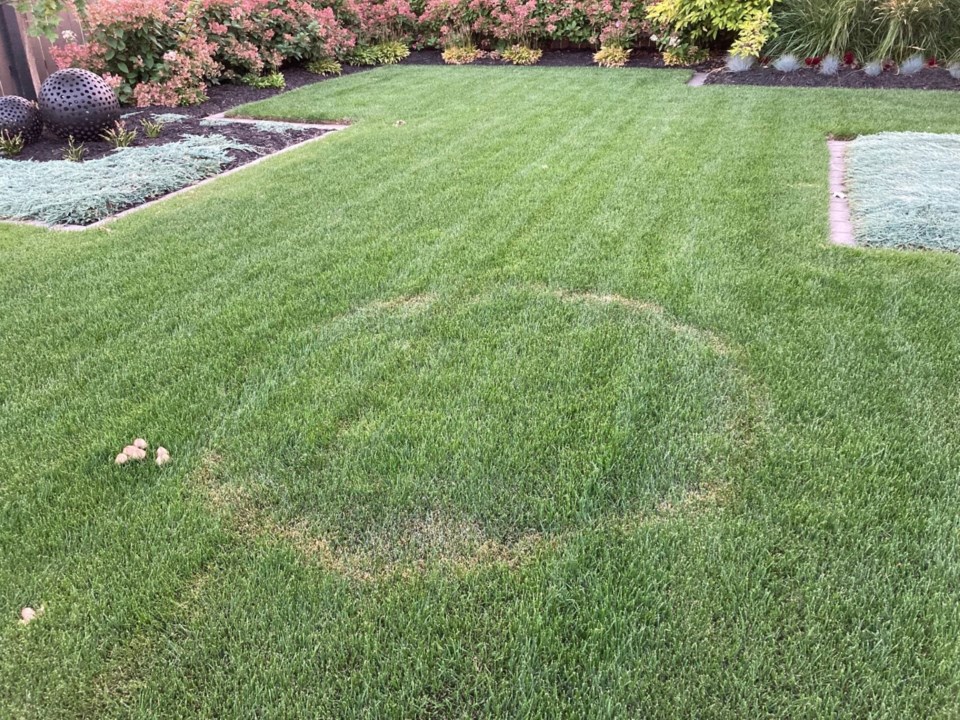Recently, I noticed two, equally-large, 1.2-m (four-foot) diameter circles on my back lawn. I’m an early riser, but I have yet to witness fairies or leprechauns dancing in circles in my backyard in the early morning mists. Just as well, as some cautionary tales warn against joining them in their dance as that might be the death of me. In Germany, a fairy ring is called a Hexenring, or witches’ ring – I want to avoid meeting up with a coven of witches, good or bad. The Dutch hold that the devil stores his milk churn in these rings and cows that wander in produce soured milk. Another possibility: is that the circles were created when extra-terrestrial visitors landed their interstellar spacecraft in my backyard. But I would probably have noticed something like that.
Science tells a different, if less imaginative, story. About 60 fungus species can produce fairy rings, the most common being Maramius oreades, found in lawns and pastures. To start, a single spore lands on a suitable spot in your lawn, germinates and starts producing mycelia (under-ground vegetative stage in the life of a mushroom) just below the lawn surface. As the fungus expands in a seemingly perfect circle or arc, the mycelium on the leading edge breaks down organic matter, releasing nitrogen and other nutrients to support its growth. The lawn directly above the leading edge also has access to these nutrients, resulting in a ring of lush green growth.
The mycelium is hydrophobic (repels water) and where the mycelial network is thickest, the lawn above may yellow and even die out due to lack of water. In addition, depending on the species, the fungus may also attack the living roots of the lawn or produce chemicals that inhibit or kill common turfgrass species. As the fungus expands, the mycelium towards the inside of the circle dies out, allowing the grass to recover. In some cases, the only thing you may notice is a ring of mushrooms after a rain, depending on the fungus species, the health of your lawn, soil type, and the source of organic matter in the soil (in my case, likely decaying tree roots from aspen trees I removed a few years ago). Fairy rings can be long-lived and reach several 100s meters wide. One in France measures over 600 metres (2000 feet) wide and is estimated to be 700 years old.
Whether from natural or supernatural origin, fairy rings are mostly an aesthetic problem, disrupting an otherwise unbroken sward of green. If you are patient, an expanding fairy ring will eventually outgrow your yard – they can grow 30-45 cm (12-18 inches) per year. In addition, they will not cross through a sidewalk, flower bed or other barrier. I learned in school that fairy rings are antagonistic towards each other: where two rings meet, those portions of the ring die out. I also learned that fairy rings are unlikely to become established where a ring has passed over previously.
If a fairy ring offends thine eye, there are a few things you can do to reduce this source of aggravation. The mushrooms can be picked and discarded (wear latex or nitrile gloves), raked out, mowed over or ignored as they are usually short-lived and generally only appear after a heavy rain or irrigation. Dethatching will remove excess organic matter, reducing their food source. To improve water penetration you’ll need to go deeper in the fairy ring than you would generally for aerating a lawn: use a garden fork to make 25-cm (10-inch) deep holes, 10-15 cm (four to six inches) apart around the entire ring; soak the now perforated ring with soapy water (five ml [one tsp] soap per four litres [one gallon] of water). Keep soaking the ring every day or second day with plain water for a month (note: no guarantee this will work to eliminate the fairy ring). Another strategy is to try to mask the lush green ring with regular fertilizer application. An extreme measure would be to strip away or kill (with a non-selective herbicide) the ring of poor lawn plus an additional 60 cm (2 feet) to each side; rototill the area thoroughly to about 30 cm (1 foot) deep; soak thoroughly; and either reseed or resod the area.
Or you can do what I’m doing: simply turn a blind eye, be patient and wait it out. And try to grab a photo or two of dancing fairies.
Erl gardens in Saskatoon
This column is provided courtesy of the Saskatchewan Perennial Society (SPS; [email protected]). Check our website () or Facebook page () for a list of upcoming gardening events.




